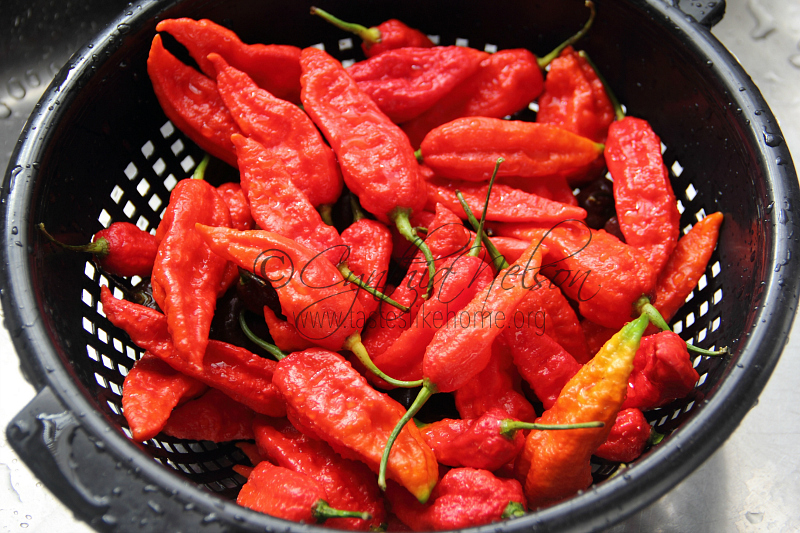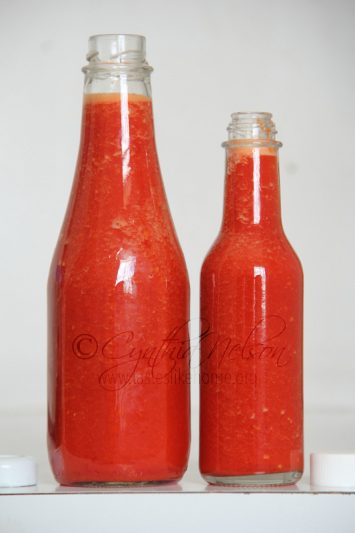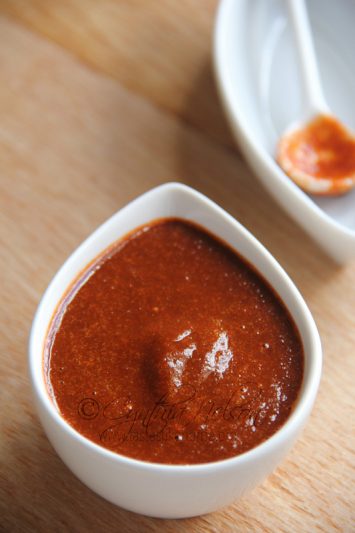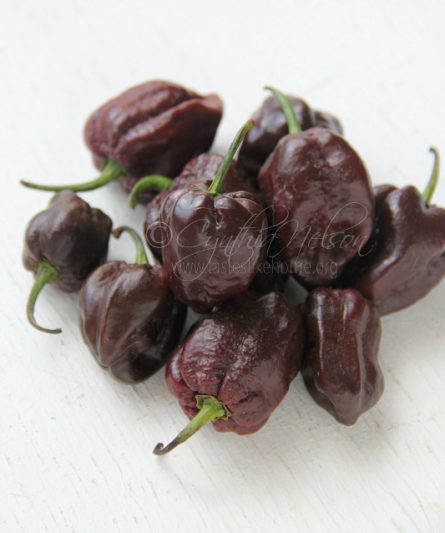Hi Everyone, This week, we continue our heat series featuring hot peppers currently in season.
Hot peppers are fascinating to heat seekers, gardeners, farmers, chefs and home cooks. Though our interest varies, the capsaicin-producing fruit that comes in a variety of colours, shapes, textures, and heat levels intrigues each one of us.
Sandra bought the seeds from one of the farming stands at the Barbados Agricultural Festival held earlier this year, in February. Sandra’s first harvest of the peppers was several weeks ago. The brown shiny peppers had us a bit stumped as to what variety they were. They looked like Scotch Bonnet but they were a little too small, and then we thought that maybe they were Trinidad’s well known, extremely fiery Brown Scorpion pepper. We satisfied ourselves with that answer with the promise to do some research.
The following week as we greeted each other, we shook our heads in union acknowledging that it was not the Trinidad Brown Scorpion. Sandra realized it because the Red Scorpion Peppers she was growing had a distinctly pointed bottom with a needle like tip indicating a scorpion’s stinging implement. I picked that up in my online research too and the other thing I noticed was that the texture of the Scorpion pepper – red or brown – was crinkly and not smooth as Sandra’s chocolate brown peppers. After scrolling through pages of images, and reading several articles on the various varieties of brown hot peppers, we concluded that the pepper was most likely Chocolate Habanero.
While we typically think of the habanero as a deep yellow to orange-coloured pepper, it also comes in other colours such as red, brown, green and purple. To taste test the Chocolate Habanero I made a pepper sauce, more on that, later.
About 3 weeks after the Chocolate Habanero made its appearance, Sandra brought a small pile of long brightly red peppers, the tips pointed, some fully red at the bottom while others had bits of orange and green. The skin was uneven and textured. I had seen photographs of Ghost Pepper (aka Bhut Jolokia) before, so I immediately recognized the pepper. Having a reputation for being lethal, I had to try it. However, having never eaten the pepper before and fearful of a pepper rated more than 1 million on the Scoville Heat Units, Sandra threw a few extra peppers on the scale after weighing my purchase. It was clear that I was alone in this heat test.
The Ghost Pepper goes by other names such as bhut jolokia, red naga, naga jolokia and ghost jolokia. It is a hybrid pepper that was cultivated in the Indian states of Arunachal Pradesh, Assam, Nagaland and Manipur. Today it is mostly grown in the Nagaland and Assam regions of northeastern India and part of
neighbouring Bangladesh. In 2007 it was certified by the Guinness Book of World Records as the world’s hottest pepper but it has been surpassed 4 times. The Carolina Reaper is currently the world’s hottest pepper and is a hybrid of the Ghost Pepper and Red Habanero.
The word, bhut means ghost and it is believed that the pepper was given that name because of the way the heat sneaks up on you when eaten. The pepper is new to us in this part of the world but it has been around for centuries. Apparently it was only introduced to the Western world in 2000. Ghost peppers come in different colours – white, red, yellow, orange, purple and chocolate brown. As with the Chocolate Habanero, I made a pepper sauce with the Ghost Pepper to taste test. Here is my opinion.
Chocolate Habanero Pepper Sauce
I made the pepper sauce with the peppers, vinegar, a little distilled water and salt to taste. I did not add other ingredients because I did not want to muddle or distort the flavour of the actual pepper. The pepper sauce was left to cure for 4 weeks.
- The thick skin of the pepper made a rather thick creamy pepper sauce that is hot and flavourful. The heat level I found to be similar to that of Scotch Bonnet.
- It arrives on the tongue with a hint of sweetness with the heat hitting at the back of the tongue.
- The heat cools down quickly so by the time you are finished chewing, you are ready for another bite of food with more of the pepper sauce. Because of this the Chocolate Habanero is perfectly suited as a condiment, you can go at it often and regularly without fear of pain.
- Highly recommend for making pepper sauce and other condiments.
Ghost (Bhut Jolokia) Pepper Sauce
Just like the Chocolate Habanero pepper sauce, this pepper sauce was made with only the peppers, vinegar, distilled water and salt to taste. It was cured for 4 weeks too.
- The first thing to note about this pepper sauce is the incredibly bright, rich, red colour. It really is a beautiful shade of red.
- The raw pepper and the sauce smell almost as hot as it tastes. The aroma frightens, almost instructing that you go lightly; the intense heat-aroma increases particularly after it has been curing for weeks.
- The skin of the pepper is thin resulting in a thinner but nevertheless creamy sauce. The texture is smooth when blended.
- When eaten, the pepper sauce stings, it is not just hot; it stings, really bad. The heat builds and builds and builds until it gets to a point where you are unsure of how much more of it you can tolerate, you are immobile. You wonder how much longer this pain is going to last. The heat subsides very, very slowly and takes quite a while to completely go away. When I ate my first mouthful of food with the pepper, I put another spoonful of food into my mouth and almost spat it out – there was heat building from the previous mouthful and heat coming in from this new spoonful of food. It was almost unbearable.
- I will, over a period of time eventually finish eating the pepper sauce I made but it is the type of pepper that I could prefer to cook with as opposed to use as a condiment. Cooking with the pepper, I can determine how small or large a piece of the pepper I want to use.
Ghost peppers are good for chopping and mixing with other ingredients to cook with for a fry up or make seasoning pastes.
- I could only eat this pepper sauce in very small quantities. It is numbingly hot.
Would I make pepper sauce with Ghost peppers again? Yes but only in combination with other peppers to balance and control the heat. While researching the pepper I learnt that the Ghost pepper produces capsaicin in sacs in both the placenta around the seeds and throughout the fruit, rather than just the placenta. This definitely explains the heat level of this pepper. We are often told, and advise people, to remove the seeds and stems (which includes the placenta) from peppers to reduce and remove the main heat components of a pepper. The ghost pepper is in another league.
Have you come across any new or unfamiliar varieties of pepper that you’d like to share about? Drop me a line.
Next week we will conclude the series looking at ways to preserve the bounty of the season.
Cynthia








